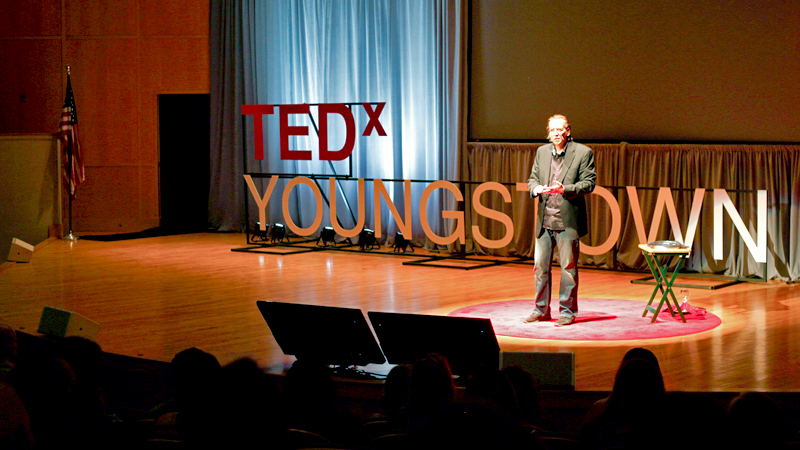TEDx presenters are short in time but long in impact

By Sean Barron
YOUNGSTOWN
Beginning at age 6, Jenilee Taylor dealt with the emotional challenges associated with losing her grandmother, Jane Grabenhorst, who had undergone brain surgery.
Since April, though, the Cuyahoga Falls woman has taken on a much happier related challenge: trying to encapsulate and distill the lessons her grandmother instilled in her into a 12-minute presentation.
“She taught me to be open and willing to make friends; she made friends with everyone she met and encouraged me to do the same thing,” Taylor explained about the recurring theme that coursed through the brief presentation she gave, titled “Emotional Glitter: The Power of Connections.”
Taylor, who owns a training and development company, was among the 20 local, out-of-state and international presenters who expounded on a variety of thought-provoking themes during Saturday’s TEDx Youngstown event in the DeYor Performing Arts Center’s Ford Family Recital Hall, downtown.
The speakers engaged in deep, 10- to 15-minute discussions on topics that delved into saving forests, handling substance and drug abuse, enduring and overcoming humiliation, taking reasonable risks, surviving the loss of a loved one and appreciating the virtues of 3D printing.
TED (Technology, Education and Design) is a nonprofit program that started in 1984 and is dedicated to spreading ideas typically via presentations 18 minutes or shorter on topics that cover science, business, health, global concerns, personal stories and other subjects in more than 100 languages. Self-organized and independently run TEDx conferences help spread and share ideas on local levels, according to the organization’s website.
Some of the presenters’ speeches have the power “to change the trajectory” of many people’s thinking and perceptions on what they had assumed was conventional wisdom in many areas, noted Greg Smith, an event organizer.
Taylor recalled that shortly after her grandmother died, she lost the desire to connect with others and became introverted as a way to squelch her pain. After undergoing brain surgery at age 17, however, Taylor remembered her grandmother’s optimism during her same illness and realized that such avoidance strategies ran contrary to what her grandmother would have wanted.
Everyone has “sparkling things” that are attractive to others, as well as “a profoundly personal assortment of small, colorful particles that reflect who we are and what we’ve been through in life,” said Taylor, who also credited her husband, Todd Taylor, for editing and shaping her presentation.
Unni Turrettini of Oslo, Norway, used the July 22, 2011, Norway terrorist attacks in which mass shooter Anders Breivik killed 77 people, most of them teenagers, as the backdrop to examine the cause and origins of many so-called lone-wolf killers – and look at how many people wear masks to hide their emotional pain.
“I felt that I needed to know how this happened by someone who lived so close to me,” Turrettini said, adding she conducted research that included consulting with an FBI profiler.
In her talk, “Scissors and Guns and the Lies We Believe,” Turrettini listed a constellation of traits she contends many mass shooters share: extreme narcissism; loneliness and sensitivity to one’s environment; high intelligence; having been subjected to bullying in school; faulty perceptions about being wronged, including blaming others; and feeling disconnected to people.
Turrettini, a former attorney who penned a book called “The Mystery of the Lone Wolf Killer,” explained that as a child, Breivik experienced tremendous rejection and exclusion, many of the same things she felt as a youngster.
She also was bullied in school, especially by a girl who taunted her mercilessly, which led to her cutting the student’s hair with a pair of scissors, Turrettini remembered.
While not justifying his actions, Turrettini said she empathizes with what he endured during his early years. After his crime, Breivik likely went from having felt insignificant to feeling like something he did mattered, she explained.
A compelling paradox, she said, is that societies have never been more connected with one another, thanks to technological advances, yet at the same time, more people than ever are dealing with loneliness.
“Our actions are dictated by our beliefs about others and ourselves,” and people must recognize the power they have to replace blaming others with changing their beliefs, she concluded.
 43
43
